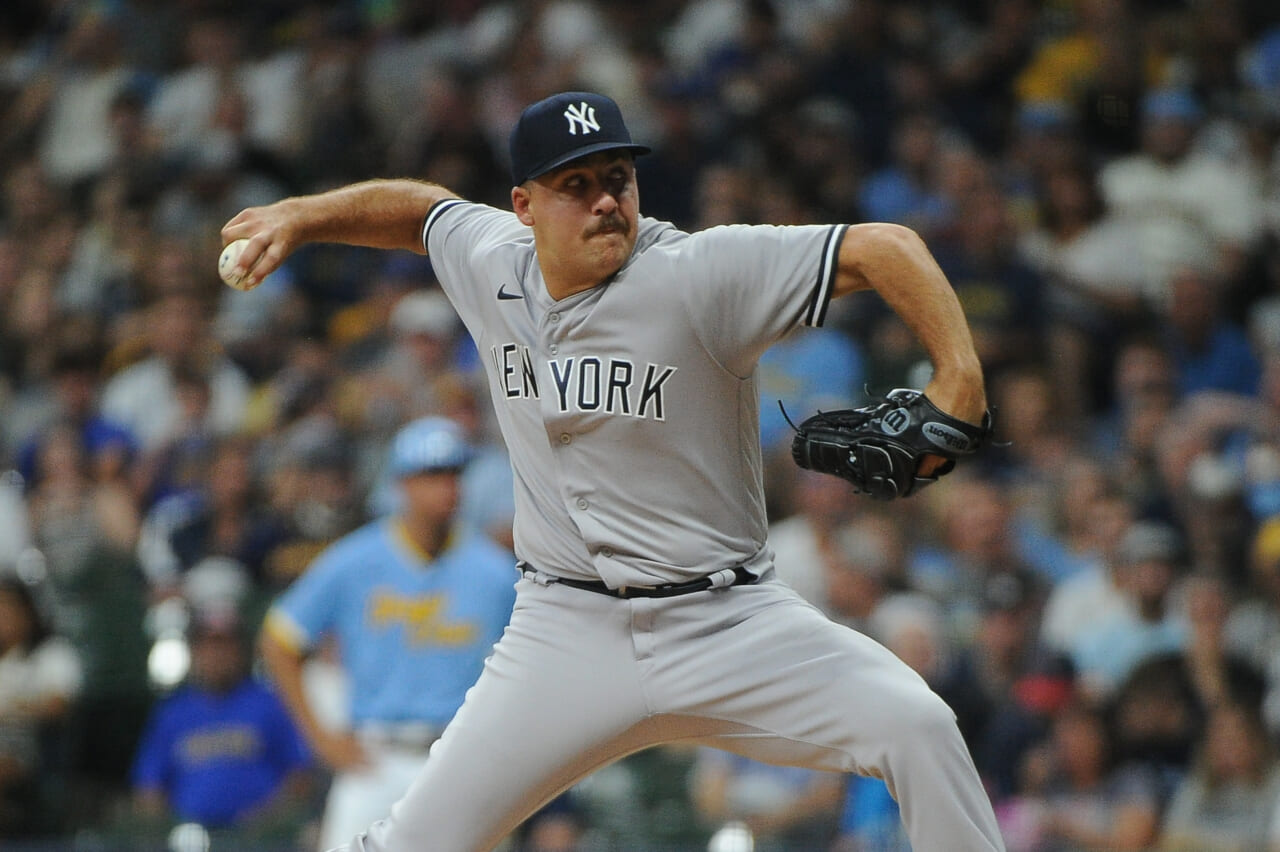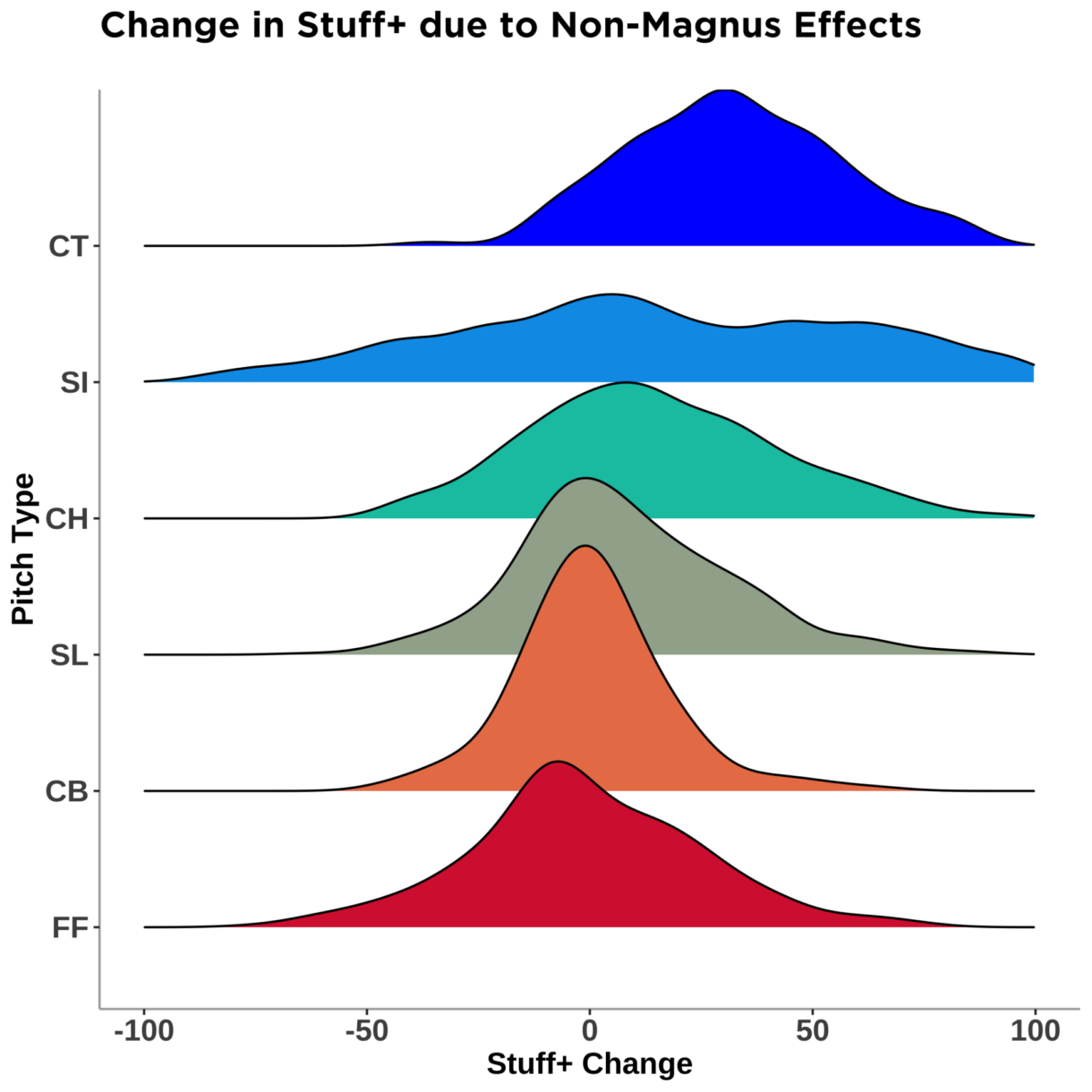
The Yankees saw the debut of RHP Greg Weissert in the 2022 campaign, who had his fair share of ups and downs in his small sample of work. With a 5.56 ERA and command issues, Weissert has a lot of work to do before he can find consistent MLB success. He has nasty stuff, there’s no denying that he’s one of their most talented and promising relievers. His deceptive arm slot and wild movement means that there are plenty of mesmerizing pitches to look at visually, but does that make someone’s pitch arsenal good?
Pitching is more complex than just creating as much movement as possible, and Weissert is a perfect example of the importance of movement with purpose. Synergy with your pitch mix is remarkably important, and it’s alluded Weissert in his time in the big leagues. With a full offseason, MLB results to evaluate, and a strong pitching development team in the Bronx, Greg Weissert could finally find what could make him a star reliever for the 2023 bullpen.
- Yankees have an overlooked infield prospect making exciting changes at the plate
- Yankees’ Brian Cashman points to major vulnerabilities on the roster
- Yankees’ new leadoff man rekindles hot bat after regression scare
Underperforming Sweeper:
Greg Weissert has one of the most impressive sliders in the entire sport when you look at the pitch data on it. I’ve discussed the importance of velocity with breaking balls pertaining to Michael King’s slider, and Weissert is another case of blending velocity and movement. Thrown at 81.8 MPH, his slider has 78% more sweep than the average slider thrown at that velocity, with 19.6″ of sweep.
Weissert’s slider looks like a frisbee, so why is it that the pitch was highly ineffective at putting batters away? In two-strike counts, Weissert’s slider performed rather poorly (.415 wOBA) despite a low AVG (.200) and a 46.2% K%. Batters averaged 98.3 MPH for their exit velocity in two-strike counts against the slider, which is extremely concerning considering that’s supposed to be his go-to pitch.
Here’s a 3-2 slider to Ke’Bryan Hayes that he reads all the way for a walk, should a pitch like Greg Weissert’s slider be so easy to take? Batters chased just 24.5% of the time against Weissert, below the MLB average of 28.4% for 2022. For someone who’s got such wicked movement, chases should be far more frequent, considering batters are supposed to see be fooled by the extra movement, not lay off of it consistently and work walks. This ties to the concept of tunneling, which helps us understand that pitchers should want pitches to have as little separation as possible at the point of committing to swinging or taking.
Not all pitches will have this minuscule separation at the point of committing, but pitch combinations in one’s arsenal serve as these lanes to generates strikeouts and weak contact. Weissert’s slider doesn’t tunnel well with his fastballs at the point of commitment, and that’s hurting his ability to consistently get whiffs. Working on that is something that is out of my realm of expertise, but work needs to be done in that department to generate consistent success in getting batters to expand the zone on the slider.
Extremely Overlooked Changeup:
When discussing tunneling, a pitch-duo that Greg Weissert possesses that could provide great results is the duo his four-seam and changeup have formed. In a shocking development, Weissert performed far better aganst LHBs than RHBs, and that’s because his changeup is surprisingly elite for a pitch not talked about much during the 2022 season. The splits between LHBs and RHBs are staggering, but they are positive signs for Weissert to find his footing at the Major League level:
- Right-Handed Batters
- 31 Batters Faced
- .311 wOBA
- 12.9% K%
- 9.7% BB%
- 1.35 WHIP
- Left-Handed Batters
- 17 Batters Faced
- .123 wOBA
- 41.2% K%
- 11.8% BB%
- 0.43 WHIP
This success against lefties stem from the fact that his FF and CH generate a whopping 13.8″ of vertical separation to go alongside 9.5 MPH of velocity separation. The goals to reach for vertical separation and velocity separation are 10″ of vertical separation and 7 MPH of velocity separation, with vertical separation being significantly more important. That added vertical separation leads to more whiffs and more groundballs, and since they tunnel well off of each other, it means batters commit before they can really identify if it’s going to be a fastball up in the zone or a changeup that’s about to have the bottom drop out on it.
I’m not suggesting replace his slider with his changeup, as increasing the usage of a pitch could worsen it’s quality on a per-rate basis, but perhaps attempting to use it a little bit more off of his FF against RHBs could yield strong results. While his sinker is a more impressive fastball visually, due to the Greg Weissert’s arm slot, his FF also creates deception. When pitchers have lower arm-slots, a batter’s eye is trained to expect that their fastball offerings will have more vertical drop, but Weissert can gets enough induced vertical break with his flat angle to fool hitters up in the zone.
This is all hypothetical, and his sinker is still a great soft-contact offering, but perhaps using with his FF-CH tunnel more could help him generate more strikeouts and greater deception.
Could the Yankees Help Weissert Develop a Cutter?
Cutters are a great pitch for one’s arsenal, providing a different look for hitters, but they can serve as a bridge between a fastball and a sweeper. Weissert could prove to be a prime candidate for a cutter, and it wouldn’t be as dramatic of a change as many think. Seam-Shifted Wake is a concept that involves how finger-placement along the seams can effect the movement of a pitch, and we can observe gaps between spin-based and actual movement due to the movement created through SSW.

The gap between the Spin-Based movement (1:45) and Observed movement (2:30) can be attributed to how his finger placement along the seams affects the path of flight for the ball. That movement is classified as Non-Magnus movement since the movement isn’t due to the spin of the ball, rather the way the seams react with air flow to create movement. This leads to pitches with spin that would suggest movement one way but end up moving completely differently.
Notice how Arraez first jumps out of the way of the batters box? He identifies the spin on the ball as a pitch that’s going to stay on it’s flight path towards his body, but instead, it darts the opposite direction for a called strike. That deception is what makes SSW so effective since batters try to pick up spin to anticipate movement. Cutters tend to greatly benefit from Non-Magnus movement, so perhaps Weissert could utilize SSW to create the horizontal bridge for his fastball and slider.

Seam-Shifted Wake plays a large role in Non-Magnus movement, but so does Gyro spin, the bullet-like spin of the ball that we see in cutters and gyro sliders. Cutters/Gyro Sliders tend to have less horizontal movement than their sweeping counterpart, but they’re still excellent pitches in their own right. Greg Weissert already doesn’t get behind the baseball much (79% Spin Efficiency on Four-Seamer), so perhaps altering the finger placement on the ball could help him generate glove-side break without altering much of what he does.
(Heavy disclaimer; I am not a pitching coach, nor am I remotely qualified to tell a professional athlete what to do, these are just ideas based on pitchers with similar repertoires or pitch data.)

Having a “glue pitch” in the cutter prevents hitters from cheating too much on the slider and simply laying off all glove-side movement, rather they now have to take risks and commit on swings, something batters already do significantly more in two-strike counts. Swing decisions heavily influence in-game outcomes, and creating swing-aggression in two-strike counts is something the cutter can help promote since batters will guess cutter at times and get a slider, or vice-versa.
Weissert needs to promote more chases, and the cutter serves as a great way to help promote those with better usage of horizontal movement.
Finding His Identity As a Reliever:
Sinker-Slider? Fastball-Changeup? New Cutter? There are a myriad of directions for Weissert to take in 2023, and they’ll depend on his comfort level with each of his pitches. The answer (as with most things) is there’s a happy medium between them all. Weissert’s got a very versatile arsenal, and he boasts ridiculous stuff that the Yankees can harness. Greg Weissert managed to post a 133.9 Stuff+, the 17th-best mark among all pitchers with at least 100 pitches thrown.
Weissert is absolutely filthy, but this offseason is about refining that movement and talent and converting it into sustainable success. The Yankees have churned a lot of high-octane arms with shaky command into reliable bullpen pieces late in games, and Greg Weissert hopes to join that long list. He’s already found his success handling opposite-handed batters, as he’s mastered the art of vertical deception with his FF-CH, but it’s about working on his horizontal profile to promote strikeouts against RHBs.
Maybe a cutter is the fix, perhaps it’s better command of his slider, or maybe it’s just a matter of getting more in-game reps. Whatever the case may be, if Greg Weissert is able to hone those horizontal profiles, he’s going to be a weapon for a Yankees team that’s already stacked in the bullpen.